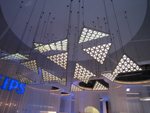Philips provides OLED outlook at The LED Show 31 Jul 2012 At The LED Show pre-conference workshop,Philips Lighting highlighted the similarities and differences between LEDs and OLEDs.The presentation also emphasized methods by which OLED cost may be reduced dramatically.OLEDs and LEDs are complimentary today,yet may someday compete in general illumination applications.This is one of the takeaways from a presentation by Angela Hohl-AbiChedid,director of business development for Philips Lighting,who also highlighted some of the methods that likely will be used to reduce the cost of manufacturing OLED panels.Hohl-AbiChedid opened the pre-conference workshop for The LED Show in Las Vegas,NV,this week.
OLEDs and LEDs
While OLEDs and LEDs are both simple semiconductor devices that create light through electron-hole recombination in response to electrical current,they are manufactured by different means and provide a different kind of light.LEDs are point light sources fabricated in a manner similar to other semiconductor chips,while OLEDs are diffused light sources that are manufactured into panels.Each panel use inorganic emissive materials that are sandwiched between a cathode layer and glass substrate(the anode).

A feature article in the debut edition of Illumination in Focus reviews OLED system efficacy,manufacturing cost,performance and lifetime challenges.Among other highlights,the article states that panel manufacturers are capable of making OLEDs today with adequate brightness for many lighting applications,in the 3000 cd/m2 range."Above around 5000 cd/m2 you begin to have glare issues,which then must be mitigated.Around 3000 to 5000 cd/m2 is a comfortable level,"said Hohl-AbiChedid.
Hohl-AbiChedid pointed out that modern applications for OLEDs and LEDs are complimentary–with OLEDs targeting skylights,task lighting,furniture,step lighting,and high-end luminaires,while LEDs have penetrated other areas including street lighting,ambient lighting,automotive lights,flashlights and replacement lamps.She stated that in terms of production volumes,OLED/LED overlap is likely to occur in task lighting first,while certain areas that require greater lumen output such as street and area lighting,will not be served by OLEDs in the near future.
One of the developments that enabled panel makers to achieve higher lumen output and brightness with OLEDs is a tandem manufacturing approach:stacking several OLED devices vertically and connecting them in series.For the same input current that is required to drive one LED device,twice the output is provided and only the voltage is doubled.In this way,two or three OLEDs are being stacked to achieve the desired lumen output.
OLEDs are particularly attractive when designers require a different panel shape or require color tuning.Rectangular and triangular OLED panels are available in custom and commercial versions,though at high cost in small quantities.Hohl-AbiChedid stated that there is little difference in price between standard and custom panels in quantities above 1000.Regarding dimming,OLEDs can be dimmed by amplitude modulation or pulse-width modulation.Certain OLEDs are capable of warming the white color upon dimming.
Tooling changes
While current OLED panels are based on a rigid glass substrate,future panels will likely be constructed of plastic and therefore flexible."We have two types of organic materials we can use in OLEDs,small molecules and polymers,which are just differentiated by their molecular weight,"said Hohl AbiChedid.She explained that OLEDs using small molecule layers are easier to make today but are more expensive because they are deposited using organic vapor-phase deposition(OVPD).OVPD is a vacuum-based process that is performed in either a cluster tool or an in-line tool.
The polymer layers offer the much less expensive option of a wet deposition tool and eventual move to high-throughput roll-to-roll processing.However,Hohl-AviChedid said,polymer solubility is currently the main technical barrier that must be overcome.Nonetheless,she expects flexible OLEDs to develop,which will open an array of new applications for OLED lighting,many of which have not been conceived.
One of the reasons OLED panels offer limited system efficacy(up to 30 lm/W),is the reflection and refraction of the emissive light off various interface layers in the OLED,especially the top glass layer.This is referred to as outcoupling.As a result,today's panels only transmit 25-30%of the illumination externally.This glass top can be eliminated,but replacement with high index-of-refraction glass,which has been investigated,is very expensive.Instead,panel makers are moving today to incorporating scattering layers to achieve efficacies in the 60 lm/W range in prototype devices according to Hohl-AbiChedid.
Interestingly,OLEDs are most efficient in a warm environment,whereas LEDs are most efficient in a cool environment,a factor that could guide their selection in the future.
All told,OLEDs are challenged to deliver a nice design with good angular light distribution,low cost,good lumen flux across a large panel size,and high lumen and maintenance.It will be the combination of device-level developments and breakthroughs in materials and equipment cost of ownership that will deliver OLED panels with more reasonable system efficacies at lower cost.





